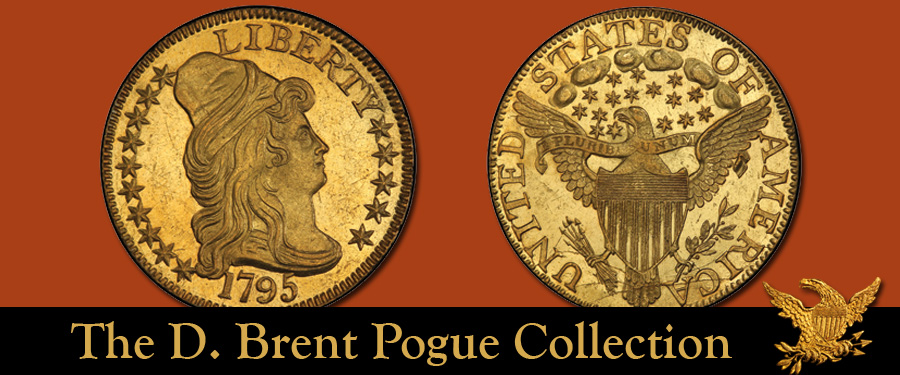
A Numismatic Landmark
Among the coins in the rarity-laden series of early half eagles of the 1790s, the variety known as Bass Dannreuther-15 is at once one of the rarest and most fascinating. The D. Brent Pogue Collection specimen is the very finest of this rarity graded by PCGS, an incredible specimen. The warm yellow gold obverse displays just a trace of soft orange patina. Attractive prooflike character in the fields. The reverse is bright yellow gold with highly reflective fields, the result of polishing of the die at the Mint. Fine striations are seen throughout, not unusual for the issue. Die cracks are seen, again usual for BD-15, and are most notable around the eagle’s tail feathers.
The mintage is not known but was probably part of the 24,867 recorded for calendar year 1798 when the Heraldic Eagle reverse became standard for this denomination. In 1795 more obverse half eagles were made than could possibly have been used in that year, so some were employed later. Three different 1795 dies were combined with Heraldic Eagle reverses, probably each for a short press run. Today these coins are rarities.
We estimate that nine to 12 Mint State coins are known, nearly all eclipsed by the Pogue Collection example. In addition an estimated 25 to 40 are known in circulated grades, mostly EF and AU. Beyond being elusive, this is one of the most famous early half eagles due to the unusual die pairing.
Notes: The 1795 Heraldic Eagle $5 represents another important illustration of a Mint technique in which still serviceable, earlier-dated dies were kept on hand and used later. For reasons such as this it is not possible to directly relate published mintage figures (such as in the Guide Book) to the actual number of pieces struck bearing a given date. It seems that Mint practices regarding overdating dies were not consistent. If a die had been made and hardened, it was not overdated, there being few exceptions to this rule. That would account for the present 1795 die not being overdated. On the other hand, if a die had been prepared with a date, but had not been hardened, it would have been an easy matter to overpunch another date, rather than to have hardened the die for use, as with 1797/5 half eagle. Stated another way, had the die used to strike the presently-offered coin been overdated, it would be 1798/5.
An early opinion of the rarity of this variety is afforded by W. Elliot Woodward’s description of the Jeremiah Colburn Collection coin auctioned as lot 1411 in October 1863:
“1795 Half eagle with spread eagle reverse of 1797; this is one of the rarest varieties in the entire American series; in splendid condition, almost Proof.”
Woodward was the most respected dealer of his time. In its October 1867 issue, the American Journal of Numismatics referred to him: “Our friend Mr. Woodward is certainly ‘the Lion of the Day,’ at least in that select and radiant sphere denominated ‘the numismatic world.’”





